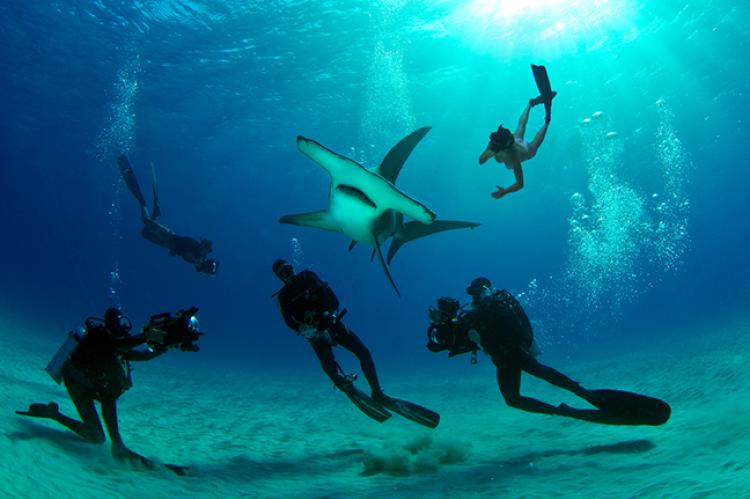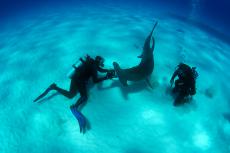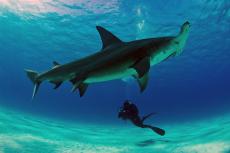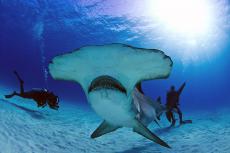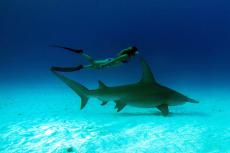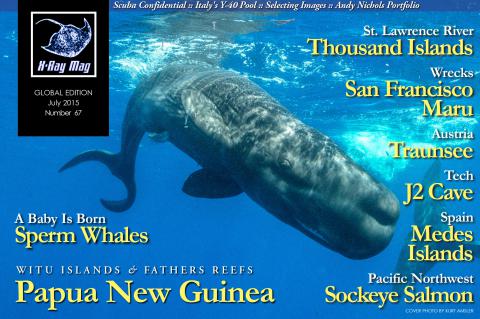The Great Hammerhead Shark
First described in 1837 by the German naturalist Eduard Rüppell, the great hammerhead shark (Sphyrna mokarran) is the largest of the hammerhead shark family and can reach a length of over 6m (20ft), although some specimens have been seen to be much larger than this. However, with overfishing, the great hammerhead is usually observed to be much smaller than this. Large congregations have been seen off the Galapagos, Cocos Island and a few small islands in the Indo Pacific—that we know off. I say that, only because there are so many island groups and atolls in the Indian Ocean and the Pacific that are never dived, that we have no idea of what can be found there.
The curious shape of the hammerhead shark has aroused much speculation over the years and it is now widely recognized that the shape of the wide hammerhead shape (called the cephalofoil), has adapted over the millions of years to be aid-specific to their main prey—stingrays, eagle rays and other bottom-living species including various crustaceans, cephalopods (squid and octopus), bony fish and other small species of shark. When attacking the rays, the shark, with its underslung jaw and outward-facing teeth, uses its wide head to pin down the ray and is then able to attack and eat the poor ray from above.
The wide head has a broad, fairly flat-edged shape of the cephalofoil, and its eyes are located at the outermost forward points. Whilst the eyes are very wide apart, they also face forward, allowing the shark much more spatial awareness of what is ahead of it. This position also protects the shark’s eyes whilst it is in attack or feeding mode. Their distinctive shape is very obvious, compared to the arched cephalofoil of the scalloped hammerhead and the smooth hammerhead. The great hammerhead’s head shape is around 27 percent of the body length, and its large dorsal fin is usually sickle-shaped.
Congregations
It is not known why hammerhead sharks congregate in large numbers, but in other aspects of marine ecosystems, generally fish, which congregate in large numbers, either do so for protection to confuse their predators or to feed, mate and breed. The former attribute is difficult to comprehend as these sharks are bottom feeders, although they have been observed (by me) to take injured fish in mid-water. As far as protection against other predators, there can surely be very few predators that would be prepared to take on a school of great hammerhead sharks, which may have several hundred in one group.
As far as the breeding and mating aspect is concerned, many fish (and mammals) never feed whilst mating and giving birth, which may account for the hammerhead sharks swimming in open water and not within their usual habitat of bottom feeding (similar in fact to their main prey species, the rays).
An endangered apex predator
Highly regarded as one of the apex predators in the ocean and once regarded as a “man-eater”, the great hammerhead shark has no known attacks on human beings, although there is a widely reported (but unconfirmed) series of attacks during WWII when an American ship sank with badly wounded servicemen in the water and many species, including hammerheads, were seen to be participating in the feeding frenzy.
The great hammerhead shark is viviparous and is able to bear litters of around 55 pups every two years. Heavily fished for the high monetary value of its large dorsal and pectoral fins, it has been assessed as "endangered" by the International Union for Conservation of Nature (IUCN).
Habitat and migration
The great hammerhead is generally found between the latitudes of 40°N and 37°S, although it is known to be seen outside these broad confines. The sharks range from North Carolina to Uruguay, including all of the Caribbean and Gulf of Mexico. (I have personally seen them off Cayman Brac in the Cayman Islands, in the Red Sea, Malaysia and Indonesia, and, of course, off the shore of Bimini where they feed in the various movements of the Gulf Stream.)
They are found off the coast of Morocco and as far south as Senegal. Most regions of the Mediterranean have records of sightings, and they may use this large inland, protected sea as a breeding ground (like the basking shark). Great hammerheads are found off Layang Layang in Malaysia, Australia, French Polynesia, California, Costa Rica, Trinidad and Peru, off the Galapagos, Scicorro, Malpelo and Cocos Islands and pretty much every other coastal location in between. In the winter months in Cayman Brac, small groups enter the protected inner lagoons in search of eagle rays; and my buddy, Mike, and I had a very close, in-your-face encounter with a HUGE beast on a night dive.
More often found in shallow coastal waters, the species is known to be migratory and will follow fairly regular routes where there are high numbers of prey species, such as the rays and other bony fish which inhabit the Gulf Stream.
Biology and behavior
Great hammerhead sharks can weigh around 230kg (500lb), but a heavily pregnant female caught with 55 pups weighed 580kg (1,280lb). Normally, great hammerheads are solitary hunters and are usually given a wide berth by other reef fish, but a number of other fish including various jacks have been seen to rub against them to perhaps rid them of parasites. Various pilotfish and remoras usually accompany the sharks, but whenever food is introduced into the environment, several sharks may congregate in the same area and appear to feed together quite happily.
Most of the great hammerhead’s electro-sensors—the Ampullae of Lorenzini—are located under the cephalofoil, and the shark can be seen sweeping its head in a side-to-side movement as it searches for prey. The ray’s “stingers” do not appear to harm the shark and caught sharks have been found with large numbers of stingers inside their mouths, behind the 17 rows of their triangular-shaped teeth. Serving as a kind of hydrofoil, the shark appears to use its cephalofoil’s shape to pivot quickly over its prey and take quick bites out of the pectoral fins of the ray to disable it before attacking it at its leisure.
Shark encounter
Stuart Cove, located on New Providence Island in the Bahamas, has run very successful shark encounter dives for many years, mainly with Caribbean reef sharks (Carcharhinus perezi), which are quite docile and easily led and fed when feeding is introduced into an arena-type of area. UNEXSO on Grand Bahama Island first championed this encounter; however, on further research and observations carried out in the Bahamas by Stuart Cove, there were found to be a huge number of different species of sharks found throughout the islands, depending on the time of year and location.
Nurse sharks are a fairly common species found throughout the Caribbean region and are seen on most dives around the Bahamas reefs. In Bimini, a few large nurse sharks had been observed fairly close to where there was a bull shark experience being conducted in the inner channel. Stuart Cove tried baiting these nurse sharks away from the bull sharks in clearer water and, low and behold, a small number of great hammerhead sharks also showed up to partake in the free meal being offered. [Whilst some may not agree with the idea of baiting sharks for the entertainment of divers, it is always undertaken with the greatest care and respect for the animals and the divers; safety as always, is paramount on all of these types of dives.]
The location for this amazing encounter was off the west coast of South Bimini and only 1km (¾ mile) outside the Bimini Bay Resort’s marina. In just 6m (20ft) of water, a spur of the Gulf Stream pushes in unhindered, over the flat and featureless sandy seabed. The current is variable, and as a safety precaution, an anchored line is placed on the seabed first to allow divers to settle on their knees on the seabed and use the rope (at waist level) to keep one in position whilst waiting for the sharks to arrive, attracted by the scent of the bait in the water.
As this was the first time that Stuart Cove had ever tried this, it was unclear what the reaction of the sharks would be to having bait and divers in the water and whether the presence of a few large nurse sharks would affect their behavior. Starting at about 1 p.m. and staying in the water until dusk (around 5.30 p.m.), we were treated to one of the most spectacular sites I have ever witnessed.
Diving with hammerheads
Once we were all in position and hooked onto the line, the current was constantly pushing at our backs, and the baiter was sending fish scraps, blood and scales over our heads. Soon, three very large nurse sharks (Ginglymostoma cirratum) appeared, and these were surrounded by literally dozens of large remora, all of which were competing for the scraps. They were rather skittish at first, but would come up to the barrier of photographers before turning away.
After around 30 minutes, the first of the great hammerhead sharks appeared. Also wary, they soon began “hoovering” up the larger fish scraps off the seabed, coming closer and closer to the line with each pass. Our adrenalin was really pumping by now, and whilst trying to regulate our breathing, the sharks paid us no heed whatsoever, and soon couldn’t even care less that there was a barrier of anchor line and divers. They would pass under the line, directly in between divers; they would circle behind us and soon were all amongst us—incredible.
I guess the fear factor had gone by that point and we were soon witnessing behavior that had never been seen before in the wild. Two 6m (20ft) great hammerheads and one smaller one at around 4m (13ft) were making passes all around us in the search for food, and as the afternoon wore on, their actions were bolder and our resolve had relaxed as we enjoyed this incredible encounter.
On day two, the current was much less and a few of the divers had left, allowing us more time in the water and more freedom of movement. Whilst we still kept behind the anchor line and close by the stern of Stuart’s dive boat (just in case!), soon we were free swimming to get the best shots of the sharks and get the other divers out of the frame. Another incredible afternoon was spent and the sharks were much more at ease around us, as we were with them. There were also three freedivers in our small band of happy underwater photographers, and they were soon duck-diving down and swimming amongst us too—what an experience!
By day three, our numbers were halved as others had to leave—shame!—leaving only four photographers, plus our freedivers; the current had virtually stopped and we dispelled with the need of the safety anchor line. For almost five hours that day, we swam and twisted and turned and interacted with these mighty sharks like never before. We stayed underwater until our air or memory cards ran out and the little time that I took to get ready and enter the water again was so slight that my dive computer didn’t record the multiple dives.
Liz Parkinson, one of the freedivers, was soon amongst us and swimming alongside the sharks as they passed between us. Liz admitted that she had reservations at first about swimming alongside the sharks, but her fears were soon dispelled. She said she loved every minute of the encounter. Liz proved to be a superb, yet unplanned model. With brilliant sunlight overhead and crystal clear water, the scene was absolutely epic!
Unlike the shark arenas elsewhere in the Bahamas where one could gauge the direction of the reef sharks’ movements, out here on a flat sandy seabed, the sharks' movements were much more unpredictable, ranging from mid-water passes to bottom feeding to just swimming all over the place; and in most cases, coming so close to us that we could do close-ups of their eyes and teeth!
Afterthoughts
This great hammerhead shark encounter run by Stuart Cove is destined to become the “Next Big Thing” for underwater photographers. Sign up now! I already have—for a return trip, combining it with a couple of Stuart Cove’s other shark encounters at Tiger Beach for tiger sharks and lemon sharks and Cat Island for oceanic whitetip sharks. ■
Lawson Wood (Lawsonwood.com) was hosted by UNEXSO (Unexso.com), Stuart Cove Dive South Ocean (Stuartcove.com) and the Bahamas Ministry of Tourism (Bahamas.com).
Download the full article ⬇︎
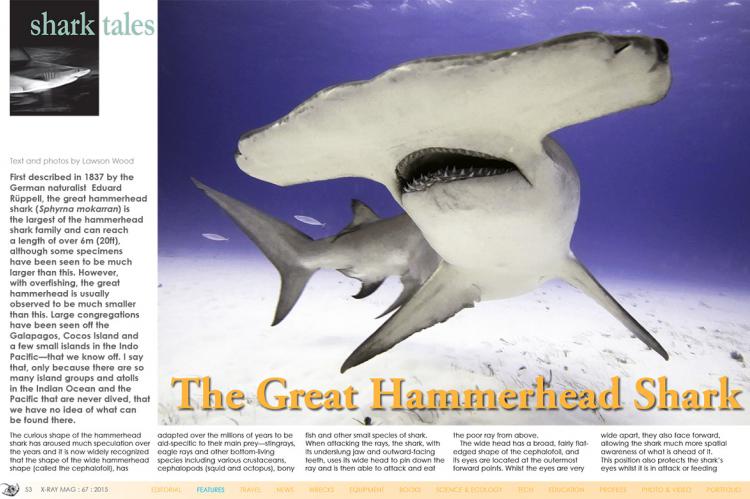
Originally published
X-Ray Mag #67
Diving Papua New Guinea's Witu Islands & Fathers Reefs; Medes Islands of Spain's Costa Brava; Austria's Traunsee; Thousand Islands of St. Lawrence River; Azore's sperm whales; Pacific Northwest sockeye salmon; Hammerhead sharks; San Francisco Maru wreck; Italy's Y-40 pool; Scuba Confidential on not always copying the pros; Mexico's J2 Cave; Selecting images; Night lenses; Andy Nichols portfolio; Plus news and discoveries, equipment and training news, books and media, underwater photo and video equipment, shark tales, whale tales and much more...


